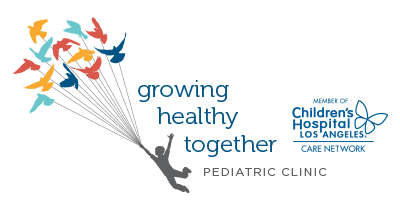Firstly, fevers usually go away within three days and are a good indication of a healthy immune response to a possible infection. If your kid has a fever, it means their immune system is active, and their body is working hard to combat a potential foreign invader. However, high temperatures or persistent fevers that are not responsive to fever reducers can indicate a more serious medical issue. Children with fevers should not go to school or daycare as they may be contagious.
Signs of Fevers
- Your child is warm to the touch
- Temperature 0f 100.7°F or higher (taken under the arm or in the mouth)
- Flushed appearance
- Sweatier or thirstier than normal
- Symptoms of illness-causing fever (e.g., sore throat, earache, rash, stomachache).
When to Stay Home
Your child should stay home if they are experiencing typical signs and symptoms of a fever.
Headaches with or without fever are not considered life-threatening. For example, your child may have both a fever and a headache, and you may initially panic. However, headaches are usually simply a sign of dehydration. As with all illnesses, it is crucial to make sure your child is well-hydrated.
Fevers are not usually serious, and you can decrease your child’s temperature at home. Use a fever reducer like Tylenol or Motrin, a cold compress, and lots of fluids. Trust your instincts and call your pediatric provider if you’re uncertain about how to respond to your child’s fever.
However, if your child has a change in mentation, neck pain, profound lethargy and/or disorientation, it is best to call your pediatric healthcare provider. Please use our guide below to help you figure out if it’s time to call the office at (562) 473-4441, to go to the ER, or to call 911.
When to Call your Pediatric Provider
- Fever for over three consecutive days without an obvious source of infection
- Neck pain
- Disorientation
- The kid isn’t playful, is confused or is having difficulty walking
- Your child refuses to eat or drink
When to Go to the ER
- Your infant under one month of age has a temperature over 100.7°F
- Your older kid has a fever over 103.5°F and isn’t responding to fever reducers
- The child is severely dehydrated or severely lethargic
- Change in mentation
- Child has a seizure
- Difficulty breathing
When to Call 911
- Your child has a fever over 105°F
- The child has a seizure.
- Your kid will not wake up
- Your child is too weak to move or stand
Choosing the Right Temperature-Taking Method
 Taking your child’s temperature is an essential part of determining how serious some illnesses are. Temperatures cannot accurately be gauged just by feeling your child’s forehead. It’s critical to choose the right method in taking your child’s temperature. An inaccurate temperature reading can cause parents to ignore a severe fever or go to the ER unnecessarily.
Taking your child’s temperature is an essential part of determining how serious some illnesses are. Temperatures cannot accurately be gauged just by feeling your child’s forehead. It’s critical to choose the right method in taking your child’s temperature. An inaccurate temperature reading can cause parents to ignore a severe fever or go to the ER unnecessarily.
When taking your child’s temperature, avoid using a mercury thermometer. Mercury poisoning can be dangerous for yourself and your family. We at Growing Healthy Together find that the regular digital thermometer works best when taking your child’s temperature. Other thermometers are user-dependent and not always correct. Digital thermometers are usually significantly cheaper, too!
When using a digital thermometer, try the under-the-tongue method first. This method can be complicated for younger kids. So, place the thermometer in the armpit (underneath clothes) with the arm against their side for reading.
Tips for Children with Fevers
- Give your child acetaminophen (Tylenol) or ibuprofen (Motrin) to reduce a fever. Check labels carefully and give your child the right dose. For children under two, follow this link to a dosing table.
- For kids two years+, try rubbing diluted peppermint essential oils (one drop in a tablespoon or more of coconut oil) on your child’s back or the bottom of their feet.
- Do not try to reduce a fever with ice packs or alcohol baths. These are no longer recommended and may have adverse effects on your child.
- Do not overdress your child or cover them in too many blankets.
- Provide plenty of fluids.
- Keep an eye out for dehydration. Signs of dehydration include dry mouth, decreased or absent urine, dark yellow urine, crying without producing tears, weakness, dizziness, and sunken soft spots, and sunken cheeks.
- Use a digital thermometer for keeping an eye on your child’s temperature.
As always, trust your instincts. You are your child’s best advocate, and you know them best. Finally, don’t be afraid to contact your pediatric healthcare provider or head to the ER, if necessary. If you are already headed to or at the ER, you can call us later to update us and schedule a follow-up appointment.
For any additional questions or comments, please respond to this blog or contact us.




